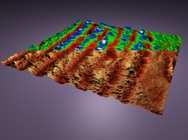Photo: In order to understand how complex materials merge at the boundary, scientists look at cross-sections of an oxide superlattices. In this picture, peaks correspond to layers of cuprate superconductor and valleys to metallic manganites (bottom region). The power of scanning tunneling microscopy allows researchers to gain insight into both the material's topography as well as its electronic properties.
ARGONNE, Ill. – Just like people, materials can sometimes exhibit “multiple personalities.” This kind of unusual behavior in a certain class of materials has compelled researchers at the U.S. Department of Energy’s Argonne National Laboratory to take a closer look at the precise mechanisms that govern the relationships between superconductivity and magnetism.
Previous measurements of magnetic and electronic properties in these superconducting oxide materials relied on aggregate or “bulk” measurements of a large area. By using advanced scanning tunneling microscopy at the laboratory’s Center for Nanoscale Materials, Argonne physicist John Freeland and materials scientist Nathan Guisinger were able to develop a clearer picture of the physical and chemical behavior of boundary regions within the material.
According to Guisinger, the most important regions of study in oxide superconductors are the boundaries or interfaces.
“You can think of the sample as kind of like lasagna,” Guisinger said. “There are layers within it that have different properties, and we want to see if the ‘cheese’ in one section mixes with the ‘sauce’ in another.”
Argonne National Laboratory: A Material's Multiple Personalities

Comments